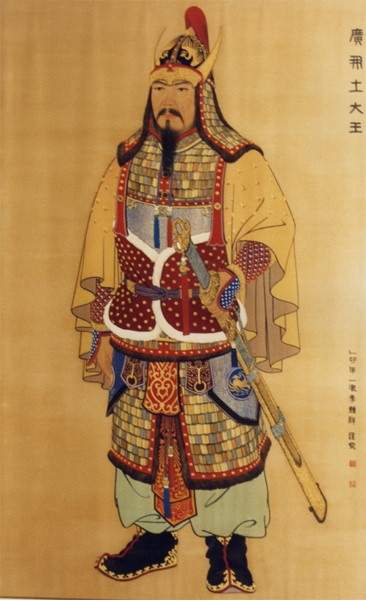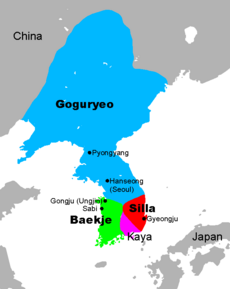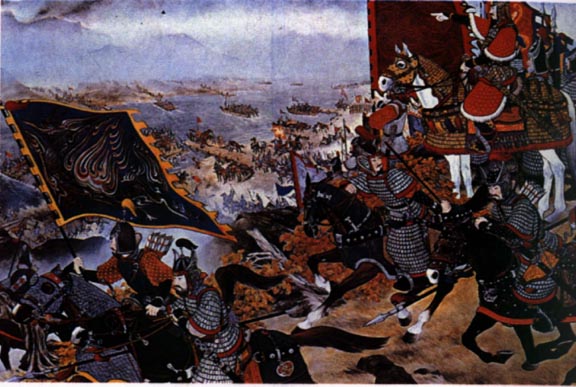In 374 C.E., in the far east, one of the greatest kings in the history of Korea – King Gwanggaeto the Great is born as Prince Damdeok, a descendant of the founder of Goguryeo Jumong and the son of King Gogukyang of Goguryeo.
He will be the first to unify the three kingdoms of Silla, Baekje, and Gaya making them tributaries under the rule of Goguryeo.

That king will live in the history of Korea as King Gwanggaeto the Great, one of the two Korean rulers who were given this title. The only other ruler bearing the title “Great” is King Sejong The Great of the Joseon Dynasty.
Gwanggaeto will become the a crowned prince of Goguryeo in 386, and later when only at the age of 17, he will lead his army to a campaign that will extend the territories of the Korean kingdom like never before and never again.
The unification of the Korean peninsula under his reign will mark the zenith of Korean history. For a short time, less than two decades, he managed to conquer a vast territory, taking numerous walled cities and over a thousand villages and tribal settlements.
The saying goes that King Gwanggaeto himself led all the attacks instead of hiding behind his castle walls. By the end of his rule and untimely death, his lands will be spread all the way from today’s North Korea to Manchuria and parts of Inner Mongolia and Siberia (Primorsky Krai).
The Military Conquests of King Gwanggaeto The Great
After the death of his father King Gogukyang, in the year 391, the young prince accepts the title Supreme King Yeongnak, meaning Supreme King of The Eternal Peace, making him equal in rank to the Chinese rulers at that time and the king of Baekje, and straight away he goes to war.
In 392, leading an army of 50,000 mounted warriors the young Korean king will march to the neighboring kingdom of Baekje, managing to capture over a dozen villages along the border.
The continues attacks over the years from 392 to 399 shrunk the Baekje kingdom and the mass conscriptions of Kings like Jinsa and Asin alienated their subjects and caused some to flee to Silla.
During those years Gwanggaeto led surprise attacks by land, sea and river, destroying about 58 Baekje fortresses. In the autumn of 393, he countered the attacks of Baekje from the north.
To protect his kingdom from the attacks he built seven fortresses alongside the borders in 394. In 396, when King Asin was preparing his capital for an attack by land, Gwanggaeto surprisingly attacked his capital from the river.
At that time, King Asin of Baekje is the 17th ruler of the kingdom. Ordering few unsuccessful attempts to stop Gwanggaeto, he decided to turn to Japan for help. Thus, as he was suffering from the vicious attacks from the north, led by King Gwanggaeto, he sought an alliance with the Wa kingdom of Japan, and sent his son Jeonji, in a try to strengthen the connection between the two kingdoms, also uniting with the southern confederacy of Gaya.
Together they attack the Kingdom of Silla, afraid that Silla may be in alliance with Goguryeo. In response, Silla turns to Goguryeo for help, and Gwanggaeto answered the call, leading his men into Silla territory and soon defeating the combined forces of the Japanese, Baekje, and Gaya.
By the end of 402 he successfully took over the Silla kingdom in the southeast, the western kingdom of Baekje, and the entire southwestern Gaya Confederacy, forcing the Japanese out of the Korean peninsula.

In the end, King Asin was hiding in his last castle – the Sanghyeon Castle, in an attempt to protect his remaining territories north of the Han River. King Asin died in 405, desperate and helpless watching his once great kingdom fall into the hands of Gwanggaeto.
Parallel with his war with Baekje Gwanggaeto succeeds in subduing the Kitan tribe in 395, conquering their capital of Beili. Then again from 400 to 404, king Gwanggaeto took control over the entire Liaodong Peninsula, defeating the Later Yan founded by the clan of Murong Xianbei, that had been engaged in warfare with the Wei to the north.
King Gwanggaeto The Great even conquers Inner Mongolia, west of Goguryeo. After that he decides to march north to the Korean kingdom of Dongbuyeo, taking control of its 64 walled cities, and in the meantime also invading the territories of Ainu and Sumo Mohe.
The Legacy of King Gwanggaeto The Great
Besides a conqueror, he is also a great politician and reformer. During his reign, he made bureaucratic reforms, aimed at centralization of the power strengthening the royal authority and unifying the state. He will also be the one to establish the Guards Institute, which is responsible for guarding the tombs of Goguryeo rulers.
Being a dedicated Buddhist he will also build in his capital of Pyongyang 9 Buddhist temples in 393 and encouraged the spreading of Buddhist religion across the Korean kingdom in order to solidify his lands. Meanwhile, Confucians Scholars are assigned to educate the future bureaucrats of the royal administration.
The land heritage of the king conqueror Gwanggaeto The Great will be kept for almost 200 years, during the rule of his son King Jangsu and till the later kingdom of Balhae. King Gwanggaeto will be remembered as the hero that restored the glory of Goguryeo and turned the kingdom into a major power in East Asia, ruling the lands in the entire Korean Peninsula and beyond.
At the age of 39, in the winter of the year 413, The Great King Gwanggaeto is struck by an unknown disease and passed away. A great conqueror and a hero for Korean society, his name – Gwanggaeto means Expander of the Realm.
In 414 his son, King Jangsu erected a Stelle in memory of his father. The 6-meter granite structure is inscribed with the history of Goguryeo, especially under the rule of King Gwanggaeto. The tomb of Gwanggaeto is believed to be on the outskirts of the Chinese city of Ji’an, near the border of North Korea and China, where the Stelle was found.
